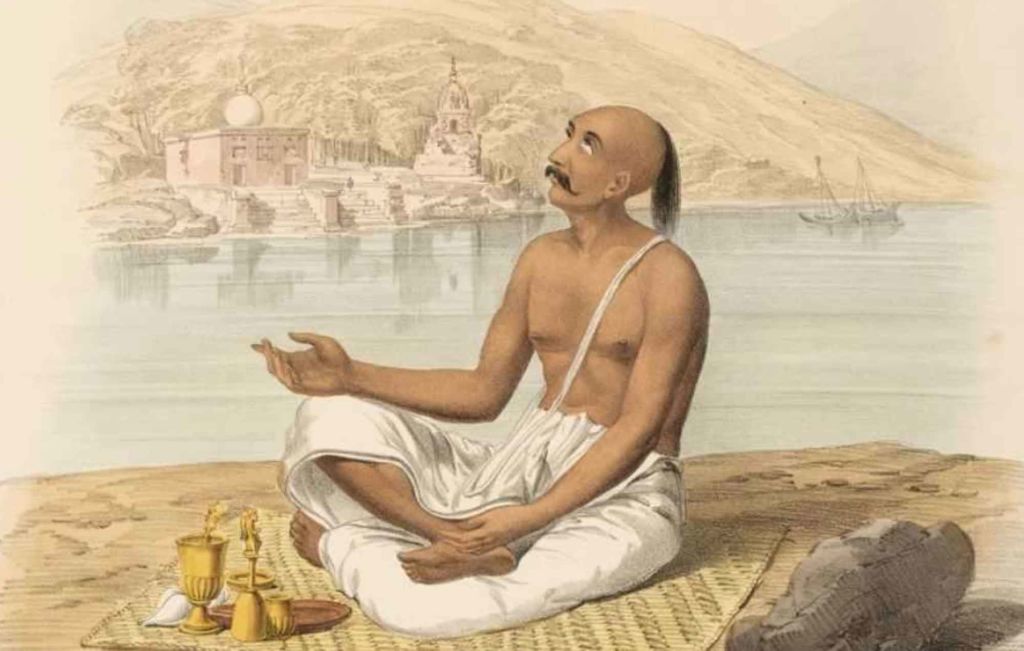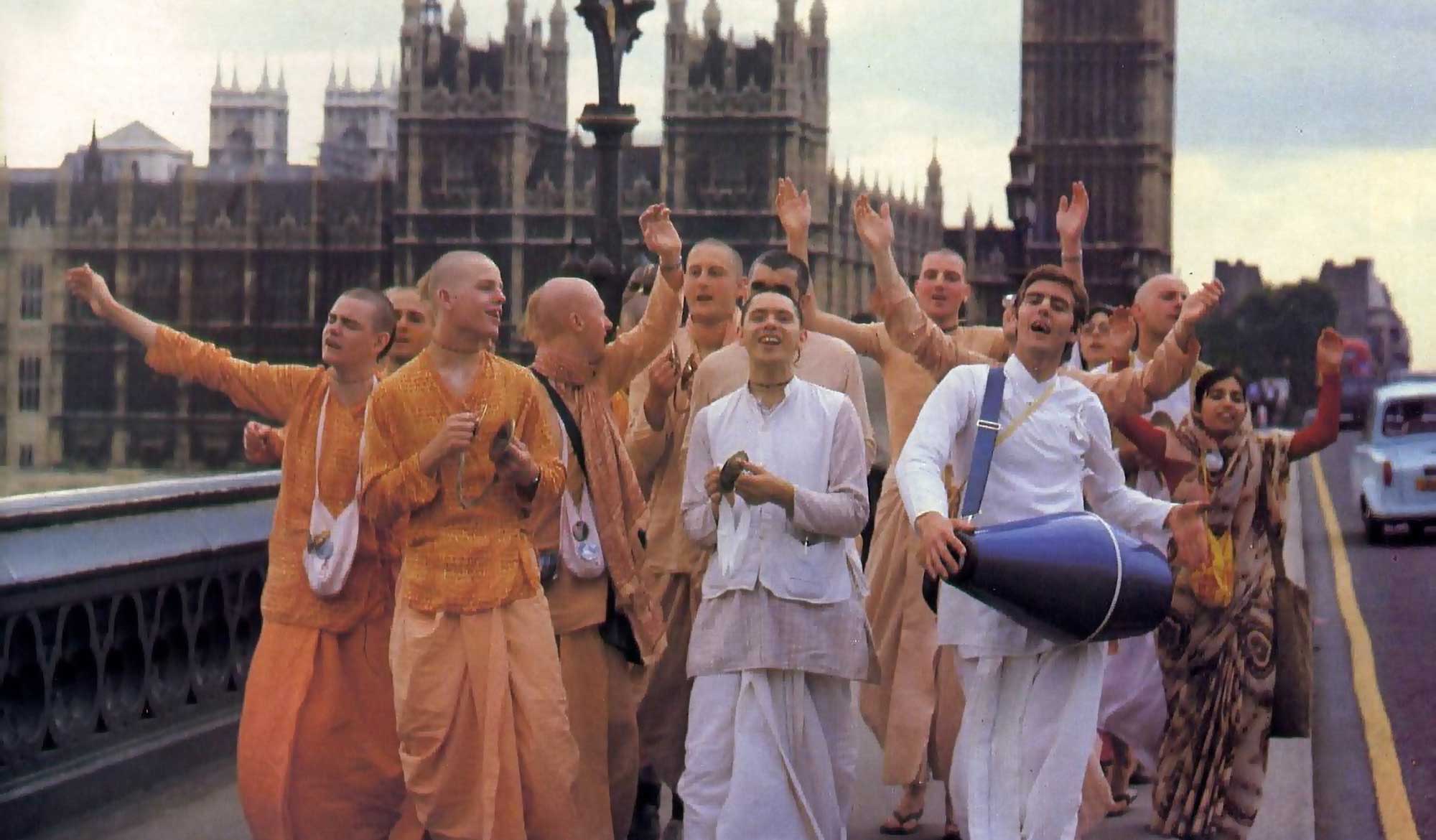Overview
‘Śraddhā and Śaraṇāgati’ was first published in Sajjana Toṣaṇī Vol. 4, Issue 9 in 1892. In this article, Bhaktivinoda Ṭhākura explains the difference between śraddhā and bhakti, the nature of śaraṇāgati, and the six limbs of surrender.
(translated by Swami B.V. Giri)
Śraddhā and Bhakti Are Not the Same
Many consider that śraddhā and bhakti are one and the same. This is not so. In the Bhakti Sandarbha Śrī Jīva Gosvāmī writes thus:
śraddhā na bhakty-aṅgaṁ kintu karmaṇy-arthi-samartha-vidvat tāvad ananyatākhyāyāṁ bhaktau adhikāri-viśeṣaṇam eva (Bhakti Sandarbha 171)
Śraddhā is not a division of bhakti, but is merely an attribute for rejecting the tendency towards karma within a person who is qualified for bhakti. Thus, the Bhāgavata says:
tāvat karmāṇi kurvīta na nirvidyeta yāvatā
mat-kathā-śravaṇādau vā śraddhā yāvan na jāyate
(Śrīmad Bhāgavatam 11.2.9)
“Hearing kṛṣṇa-kathā, kīrtana etc. are devotional activities. Only when there is śraddhā in those things will the qualification for bhakti–tattva manifest. From that time on, the tendency for karma ceases.”
Therefore, it is written in the Āmnāya-sūtras:
anyopāya-varjaṁ bhakty-unmukhī citta-vṛtti-viśeṣaḥ
(Āmnāya-sūtra 2.2.57)
“Jñāna and karma are not the best way to achieve prayojana-siddhi (perfection in attaining one’s goal); bhakti is the only pure way. The faith one has in his heart towards exclusive bhakti is known as śraddhā.”
Scholars who are expert in tattva equate śraddhā and śaraṇāgati as one. In the Bhakti Sandarbha it is said:
karma-parityāga-hetutvenābhidhānāt śraddhā-śaraṇāpattyor aikārthyaṁ labhyate, tac ca yuktam śraddhā hi śāstrārtha-viśvāsaḥ śāstraṁ ca tad-aśaraṇasya bhayaṁ, tac-charaṇasyābhayaṁ vadati tato jātāyāḥ śraddhāyāḥ śaraṇāpattir eva liṅgam iti (Bhakti Sandarbha 173)
“Since the statement of Bhagavān, tāvat karmāṇi kurvīta etc. refers to śraddhā as the renunciation of karma, śraddhā and śaraṇapatti are considered to be one and the same. Faith in the meaning of the śāstra is called śraddhā. The śāstra explains that a jīva who is not surrendered to Śrī Kṛṣṇa is fearful, and those that are surrendered have no fear. Thus, śraddhā manifests as a sign of śaranāpatti.”
This essential conclusion can be achieved by deliberating upon all the śāstra. The conclusion of all the śāstra is spoken in Śrī Bhagavad–gītā in it’s most important śloka:
sarva-dharmān parityajya mām ekaṁ śaraṇaṁ vraja
ahaṁ tvāṁ sarva-pāpebhyo mokṣayiṣyāmi mā śucaḥ
(Bhagavad-gītā 18.66)
“O Arjuna! You should abandon the karma, jñāna, yoga etc. spoken of in the śāstra and surrender unto Me. I will deliver you from all types of contamination – do not lament!”
There is no benefit in any other method apart from surrendering to Śrī Kṛṣṇa’s feet. Therefore, we should take refuge in such a fearless position. The name for such firm belief is śraddhā, śaraṇāpatti or prapatti. In this regard, please consider what such surrendered persons are saying in these statements from Śrī Bhakti-rasāmṛta-sindhu:
kāmādīnāṁ kati na katidhā pālitā durnideśās
teṣāṁ jātā mayi na karuṇā na trapā nopaśāntiḥ
utsṛjyaitān atha yadu-pate sāmprataṁ labdha-buddhis
tvām āyātaḥ śaraṇam abhayaṁ māṁ niyuṅkṣvātma-dāsye
(Bhakti-rasāmṛta-sindhu 3.2.35)
“Lord! Subdued by lust, anger etc. I have obeyed their wicked demands. Yet they never showed me any mercy, nor did they feel ashamed or appeased. O Kṛṣṇa! Now I have understood the purport of the śāstra by hearing from a guru, and I have taken shelter of You. Please be merciful and give me Your service.”
aho mahātman bahu-doṣa-duṣṭo ‘py ekena bhāty eṣa bhavo guṇena
sat-saṅgamākhyena sukhāvahena kṛtādya no yena kṛśā mumukṣā
(Bhakti-rasāmṛta-sindhu 3.2.27)
“O mahātmā! Although this human birth is extremely flawed, the quality of sādhu–saṅga still exists. By taking shelter in that quality, our longings for mukti or material desires become weak.”
dhyānātītaṁ kim api paramaṁ ye tu jānanti tattvaṁ
teṣām āstām hṛdaya-kuhare śuddha-cin-mātra ātmā
asmākaṁ tu prakṛti-madhuraḥ smera-vaktrāravindo
megha-śyāmaḥ kanaka-paridhiḥ paṅkajākṣo ‘yam ātmā
(Padyāvalī 77)
“We have nothing to say about those who claim that they have become aware of that non-differentiated Reality beyond meditation. Only the ātmā of pure consciousness resides in their hearts and not the divine pastimes. But may that ātmā with His sweet smiling face, lotus eyes, yellow cloth, and complexion like a dark rain cloud, remain within our hearts.”
In the Tenth Canto, Akrura states:
kaḥ paṇḍitas tvad aparaṁ śaraṇaṁ samīyād
bhakta-priyād ṛta-giraḥ suhṛdaḥ kṛta-jñāt
sarvān dadāti suhṛdo bhajato ‘bhikāmān
ātmānam apy upacayāpacayau na yasya
(Bhakti-rasāmṛta-sindhu 3.2.28)
“O Bhagavān! Your devotees are every dear to You, You are always true, most friendly and grateful. Which scholar would approach anyone else for shelter apart from You? To those who worship You in intimate friendship You bestow everything they desire, including Your own self, yet You never increase or diminish.”
Three Kinds of Śraddhā
There are three kinds of śraddhā – high, medium and low. Thus, there are three types of people endowed with śraddhā in the category of uttama, madhyama and kaniṣṭha. As Śrī Rūpa states in Bhakti–rasāmṛta–sindhu:
śāstre yuktau ca nipuṇaḥ sarvathā dṛḍha-niścayaḥ
prauḍha-śraddho ’dhikārī yaḥ sa bhaktāv uttamo mataḥ
(Bhakti–rasāmṛta–sindhu 1.2.17)
yaḥ śāstrādiṣv anipuṇaḥ śraddhāvān sa tu madhyamaḥ
yo bhavet komala-śraddhaḥ sa kaniṣṭho nigadyate
(Bhakti–rasāmṛta–sindhu 1.2.19)
“One who is expert in the śāstra and in logic, who is always resolute, has high class śraddhā. He has uttama-adhikārī bhakti. One who is not particularly expert in the śāstra or logic, yet has firm śraddhā, has madhyama–adhikārī bhakti. One who has attained a little śraddhā from the others, but has not taken shelter of the śāstra or logic is endowed with komala–śraddhā (immature faith). Through sādhu–saṅga and faith in the śāstra, he too can gradually attain high class śraddhā.”
The three states of śraddhā are also the three states of śaraṇāpatti, since śaraṇāpatti is only a symptom of śraddhā in the heart. Now considering the word śaraṇāpatti, the real meaning of both the words śraddhā and śaraṇāpatti will be understood.
Six Classifications of Śaraṇāgati
It is written thus in the Vaiṣṇava Tantra:
ānukūlyasya saṅkalpaḥ prātikūlyasya varjanam
rakṣiṣyatīti viśvāso goptṛtve varaṇaṁ tathā
ātma-nikṣepa-kārpaṇye ṣaḍ-vidhā śaraṇāgatiḥ
There are six classifications of śaraṇāgati:
1) Accepting that which is favourable.
2) Rejecting that which is unfavourable
3) Having faith that Kṛṣṇa will certainly protect me
4) Having knowledge that Kṛṣṇa is my maintainer
5) Surrendering one’s very self
6) Humility
These six types of śaraṇāgati are classified in three ways, as physical, verbal and mental. This is what Śrī Jīva says about śaraṇāgati:
ṣaḍ-vargādy-avikṛta-saṁsāra-bhaya-bādhyamāna eva hi śaraṇaṁ praviśaty ananya-gatiḥ. bhakti-mātra-kāmo’pi tat-kṛta-bhagavad-vaimukhya-bādhyamānaḥ. ananya-gatitvaṁ ca dvidhā darśyate—āśrayāntarasyābhāva-kathanena, atiprajñaya kathañcid āśritasyānyasya tyājanena ca. (Bhakti Sandarbha 236)
“Afflicted by fear of saṁsāra by the six enemies lust, anger, greed, delusion etc. a fortunate jīva finds no other shelter and surrenders at the feet of Śrī Kṛṣṇa. Although he only desires pure bhakti, he is affected by aversion to Bhagavān through these enemies, but realises that He must take shelter of Him. There are two ways of taking shelter. One way of taking shelter is to declare that he has no other refuge. “O Kṛṣṇa! I have thoroughly reviewed the pleasures of this mundane world, the pleasures of karma and its results of enjoyment, as well as jñāna and its result of liberation. I see that I am the cit–svarūpa–ātmā and that I am Yours, and there is no other true shelter except for Your feet which award fearlessness. I have taken refuge in You.” The second way of taking shelter is this – “O Kṛṣṇa! I have thought of taking shelter of karma–kāṇḍa, taken refuge in various Devatās, spent millions of lifetimes considering varṇāśrama–dharma, yajñā, vratas etc. Yet none of these kinds of things gave eternal happiness. Yet again, taking shelter of jñāna, I took refuge in impersonal Brahman and experienced a taste of mukti, but there was no eternal bliss. After experiencing all these states, O Lord, I have given up their shelter and have now taken refuge in Your nectarean lotus feet.”
Now we will deliberate upon the six categories of śaraṇāgati separately. Let us consider the first – accepting that which is favourable (anukūlya). When the jīva attains śraddhā in exclusive kṛṣṇa–bhakti, then he resolves, “I will accept all those things that are anukūla to kṛṣṇa–bhakti.” How can bhakti be cultivated if one does not accept those things that are appropriate? Bound in saṁsāra, he spends his life meditating upon material objects. Meditation upon those things binds us again and again to those sense-objects. Thus, kṛṣṇa–bhakti will be cultivated only when one vows to accept those things that are anukūla for bhakti, and then gradually the bondage of material sense objects will be eradicated. According to the manner revealed by Śrī Jīva Gosvāmī, I am discussing separately the three different things that are anukūla in terms of physical, verbal and mental.
1) The path of tasting.
2) The path of hearing.
3) The path of seeing.
4) The path of using one’s hands, feet and body.
5) The path of smelling.
The only way to make the tongue conducive to bhakti is to vow to honour the prasāda of Śrī Kṛṣna and the devotees. At the time of honouring prasāda, one does not think of becoming happy through enjoying, but only thinks of how the Lord of one’s life, Śrī Kṛṣṇa, has become happy by eating. At the time of honouring prasāda, if one feels happy enjoying himself, then there is no mood of anukūlya.
The only way to make the eyes conducive to bhakti is to vow to take darśana of the Deity, the Vaiṣṇavas, the various beautiful places of Bhagavān’s līlā, pictures of the Lord’s pastimes etc. In all that is subject to the eye, the main requirement is to see everything in relation to Bhagavān.
In order to make smelling conducive to bhakti, the vow of accepting the scent of tulasī, flowers, sandalwood and other fragrances that are offered to Kṛṣṇa is the only way. Whatever scent is accepted, should be done so in relation to Kṛṣṇa. Thus we find in the Third Canto:
tasyāravinda-nayanasya padāravinda-
kiñjalka-miśra-tulasī-makaranda-vāyuḥ
antar-gataḥ sva-vivareṇa cakāra teṣāṁ
saṅkṣobham akṣara-juṣām api citta-tanvoḥ
(Śrīmad Bhāgavatam 3.15.43)
“Sanat, Sanātana etc. were previously inclined towards the state of impersonal Brahman, but when the scent of tulasī mixed with sandalwood paste on the lotus feet of Kṛṣṇa entered their nostrils, then they experienced a change both in body and in mind, and bhakti was manifest within them.”
The only way to make hearing favorable to bhakti is to vow that one will only listen to hari-kathā, bhakta-kathā and those topics related to Hari. Thus we find in the Third Canto:
yac ca vrajanty animiṣām ṛṣabhānuvṛttyā
dūre yamā hy upari naḥ spṛhaṇīya-śīlāḥ
bhartur mithaḥ suyaśasaḥ kathanānurāga-
vaiklavya-bāṣpa-kalayā pulakī-kṛtāṅgāḥ
(Śrīmad Bhāgavatam 3.15.25)
“Brahmā said, ‘O Devas! Those who discuss hari-kathā with each other, and by doing so go through various transformations due to bhakti, are capable of ascending to the eternal abode.”
The only way to make the hands, feet and body favorable to bhakti is to vow to only use them in bhagavat-sevā and vaiṣṇava-sevā. Thus we find in the Ninth Canto:
sa vai manaḥ kṛṣṇa-padāravindayor
vacāṁsi vaikuṇṭha-guṇānuvarṇane
karau harer mandira-mārjanādiṣu
śrutiṁ cakārācyuta-sat-kathodaye
mukunda-liṅgālaya-darśane dṛśau
tad-bhṛtya-gātra-sparśe ’ṅga-saṅgamam
ghrāṇaṁ ca tat-pāda-saroja-saurabhe
śrīmat-tulasyā rasanāṁ tad-arpite
pādau hareḥ kṣetra-padānusarpaṇe
śiro hṛṣīkeśa-padābhivandane
kāmaṁ ca dāsye na tu kāma-kāmyayā
yathottamaśloka-janāśrayā ratiḥ
(Śrīmad Bhāgavatam 9.4.18-20)
“Due to the pure love of Kṛṣṇa’s devotees, they engage their mind in thoughts of the lotus feet of Kṛṣṇa, their words in describing Kṛṣṇa’s qualities, their hands in cleaning Kṛṣṇa’s temple, their ears in hearing topics about Kṛṣṇa, their eyes in seeing the Deity in Kṛṣṇa’s temple, the senses in touching the body of the devotees of Kṛṣṇa, their sense of smell by smelling the scent of the tulasī on the lotus feet of Kṛṣṇa, their sense of taste by tasting those things offered to Kṛṣṇa, their feet by travelling to the pastime places of Kṛṣṇa, their head by offering respects at the lotus feet of Kṛṣṇa, and being devoid of any desire of enjoyment for themselves, they are engaged in serving the desires of Kṛṣṇa.”
In this way, one’s consciousness can be fixed upon Kṛṣṇa. The esteemed Gosvāmī has said:
hṛṣīkeśe hṛṣīkāṇi yasya sthairya-gatāni hi
sa eva dhairyam āpnoti saṁsāre jīva-cañcale
(Caitanya-caritāmṛta, Madhya-līlā 24.184)
“One whose senses are fixed on Kṛṣṇa, the Master of all senses, is is able to gain endurance in this restless world.”
The Mental Categories of Śaranāpatti
These are physical forms of śaranāpatti. The mental categories of śaranāpatti are thus:
1) The path of meditation (dhyāna).
2) The path of deliberation (vicāra).
3) The path of relishing (āsvādana).
The activity of the mind is meditation, and the activity of the intellect is deliberation. In order to make all thoughts, all deliberations and all types of relishing favourable to bhakti, the activities of the mind must be established in relation to Kṛṣṇa. If all practical conversations, songs and poems can be related to Kṛṣṇa, then ānukūlya can be achieved. Thus we find in the Tantra:
tavāsmīti vadan vācā tathaiva manasā vidan
tat-sthānam āśritas tanvā modate śaraṇāgataḥ
(Hari-bhakti-vilāsa 11.417-418)
“By stating with his words, ‘O Kṛṣṇa! I am Yours!’ feeling this in his mind, and by surrendering his body in taking refuge of the holy places of Kṛṣna, a surrendered person experiences bliss.”
Rejecting that which is unfavourable (prātikūlya-varjana) is the second limb of śaraṇāgati. It is also divided into the threefold divisions of physical, verbal and mental. “I will not eat anything except the prasāda of the Lord and His devotees, I will not look at anything except for temples and the Lord and His devotees, I will not smell anything except for prasāda, I will not listen to anything except hari-kathā, I will not engage my hands, feet or body in that which is not connected to Bhagavān, I will not meditate upon, deliberate upon or relish anything else, I will not recite or sing any other poetry or songs” – such a compilation of topics is rejecting those things that are unfavourable. As a result, whatever has been mentioned by the Lord as detrimental for sādhana is to be discarded. This is very difficult for a person residing in this material world. It should be done as much as possible, for without endeavouring to observe this, ekāntiki-bhakti (exclusive firm devotion) will be extremely difficult to achieve. I will summarize all the words of the śāstra in regards to this. In the Padma Purāṇa:
avaiṣṇavānām-annam ca patitānāṁ tathaiva ca
anarpitaṁ tathā viṣṇau śvamāṁsa sadṛśaṁ bhavet
“Food that is given by non-Vaiṣṇavas, by fallen persons or food which is not offered to Kṛṣṇa is as good as dog-flesh and should be rejected.”
The Lord says:
asadbhiḥ saha saṅgas tu na kartavyaḥ kadācana
yasmāt sarvārtha hāniḥ syād adhaḥ pātaś ca jāyate
(Hari-bhakti-vilāsa 10.294)
“One should never associate with persons who are asat (materialists). Those addicted to vice and attached to material objects are basically asat. Even amongst those who are pious or who are expert in śāstra, if they are devoid of kṛṣṇa-bhakti or averse to the Vaiṣṇavas, one should avoid their company because they are certainly asat. By associating with those that are asat, all of ones worthwhile objects are destroyed and one falls down.”
na tathāsya bhaven moho bandhaś cānya-prasaṅgataḥ
yoṣit-saṅgād yathā puṁso yathā tat-saṅgi-saṅgataḥ
(Śrīmad Bhāgavatam 3.31.35)
“A jīva’s bondage and bewilderment is not so much due to attachment to objects as it is due to his attachment to women and to his association with those men who are attached to women.”
“Kṛṣṇa is certainly my Protector!” – This type of faith is the third limb of śaranāpatti. Kṛṣṇa tells Arjuna:
kaunteya pratijānī hi na me bhaktaḥ praṇaśyati
(Bhagavad-gītā 9.31)
“O Kaunteya! Declare to everyone this promise of Mine that My devotee will never perish. Based on the strength of their dharma, the karmīs and jñānīs will be protected. But even if My devotee falls down, I am his protector.”
Those that are surrendered have firm faith in this statement.
“Śrī Kṛṣṇa is My only Maintainer!” – this mentality is the fourth limb of śaraṇāgati. “Other persons are maintained by me” or “I have acquired you and I will maintain you.” – this mentality is extremely contemptible. “If Kṛṣṇa does not approve, no one can be maintained by me and I cannot earn anything myself. Therefore, other than Kṛṣṇa, I have no other maintainer.”
The jīva’s full surrender (ātma-nivedana) is the fifth limb of śaraṇāgati. “I am nobody! Everything I say that is mine belongs to Kṛṣṇa. I am only a slave in Kṛṣṇa’s family. Kṛṣṇa’s desire is strong. My individual desires are futile. My inherent nature is to acquiesce to the desires of Kṛṣṇa. Under the spell of foolishness, till now, all the objects and people that I thought as mine, I offer unto Śrī Kṛṣṇa. From this day on, I am not for myself, I am Kṛṣṇa’s!” This mentality is called ātma-nivedana.
Kārpaṇya or dainya (humility) is the sixth limb of śaraṇāgati. “I am a spiritual jīva. I am experiencing various miseries in this material world due to the faults of my own activities. I am a worthy recipient of punishment. Being an eternal servant of the all-merciful Kṛṣṇa, I neglected the shelter of His feet and entered the cycle of karma where there are so many tribulations. Is there anyone as unfortunate as myself? I am most fallen, despicable and lowly.”
One whose heart and character becomes purified by these six limbs of śaraṇāgati is certainly an eligible candidate for pure bhakti.













